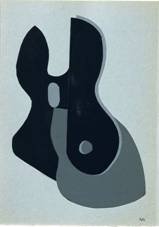Dialogue Without Encounter
dal 12/2/2008 al 11/5/2008
Segnalato da
Press Office of the Pinakothek Museums
12/2/2008
Dialogue Without Encounter
Pinakothek der Moderne, Munich
The 60 works in this exhibition - in the case of Arp focusing principally on collage and relief and in the case of Winter on his "bio-morph" works of art in the early 1930s - illustrate an artistic dialogue which reflects in Winter's reception of Arp an issue that has shaped contemporary art.

Curator: Dr. Cathrin Klingsohr-Leroy
The 60 works in this exhibition – in the case of Arp focusing principally on collage and relief and in the case of Winter on his »bio-morph« works of art in the early 1930s – illustrate an artistic dialogue which reflects in Winter’s reception of Arp an issue that has shaped contemporary art.
Winter’s reminiscence of Arp is remarkable for the fact that there are no reference points to indicate such an artistic affinity, neither in Arp’s biography nor in Winter’s.
Hans Arp, one of the most glittering figures of the avant-garde in the first half of the 20th century, worked with equal ease as a poet, painter and sculptor. He was a founding member of the Dada movement, exhibited alongside the Surrealists and belonged to the »Cercle et Carré« and »Abstraction–Création« groups. From1927 onwards he lived and worked in Meudon near Paris. There he embarked on a new phase of work as an artist, one that was strongly influenced by sculpture.
Fritz Winter, by contrast, was still shaping his artistic identity at that time, having just completed his training at the Bauhaus. Initially, he modelled himself on the work of Paul Klee and Ernst Ludwig Kirchner. Based on his collaboration with Naum Gabo, he then engaged in a discourse with constructivism. Fritz Winter developed a style shaped by light-filled transparency, stringent, geometric forms and spherical movement. However, some of the works associated with this style demonstrate certain discrepancies in Winter’s »constructivist« approach: Organic shapes, »natural« materials such as sand and fabric, relief-like structures suddenly featuring in Fritz Winter’s work allow something entirely different and new to emerge from the same foundations.
In 1931 Fritz Winter created a sequence of twelve paper collages whose bio-morph language of form, asymmetric composition and vivid colour were a clear reminder of Hans Arp’s work. A series of Winter’s drawings and paintings from the same period also adopt form elements of Hans Arp: the torso, the much varied oval, the soft line that seemingly forms a shape of its own accord.
The inspiring juxtaposition of the works by Hans Arp and Fritz Winter adopts a concept fundamental to the exhibitions held by the Fritz-Winter-Stiftung – that of presenting Fritz Winter in context.
Combined with the opening of the exhibition, Olafur Eliasson will receive the Fritz Winter Prize 2008. In granting him this award, the foundation has chosen a prize-winner who not only comes from the fine arts but who is also, despite his different artistic approach, close to Fritz Winter in sharing his ideas that art as much as science should be committed to exploring nature.
Opening: 13 february 2008 at 19
Pinakothek Museums
Kunstareal, Barer Str. 29, 80799 Munich



